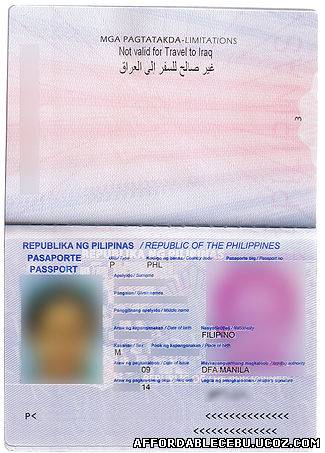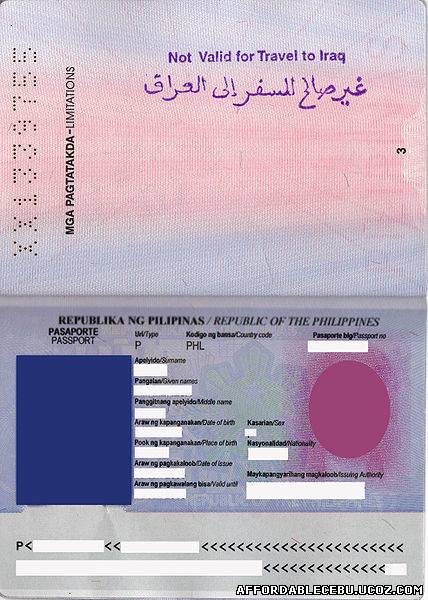Here are the pictures of the GENUINE Philippine Passport: 
The data page of the biometric passport with a machine-readable zone and digitally-captured signature.

The data page of the maroon-style machine-readable passport with a machine-readable zone.
Physical appearance
The data page of the biometric passport with a machine-readable zone and digitally-captured signature.
The data page of the maroon-style machine-readable passport with a machine-readable zone.
A Philippine passport has a maroon cover with the coat of arms of the Philippines emblazoned in the center. The cover contains the Filipino words "PILIPINAS" on top and "PASAPORTE" on the bottom. Passports issued in the late Marcos era (1980-1986) had the order reversed (strikingly similar to the United States passport), with "PASAPORTE" on top and "REPUBLIKA NG PILIPINAS" on the bottom. All passports issued since the late Marcos era have the cover in Filipino save for the SIRB, where the cover text is in English.
A typical passport has 44 (previously 32 or 64) pages.
Languages
Philippine passports are issued in both English and Filipino, with Filipino preceding English. All text in Filipino in brown passports were written with diacritics included, although diacritics are no longer used in green and maroon passports.
The information on a passport's data page are written in Filipino and English.
Data page
Philippine passports have different styles of data pages. Old brown passports have both a data and physical description page, with the picture located on the description page rather than the data page, which are separated by the passport note. Green passports issued before 2004 have the data page on the inner cover followed by the passport note page. Passports issued after 2004 have the passport note and data pages reversed, with the passport note on the inner cover page.
The data page contains the following information:
* Passport type (P)
* Country code (PHL)
* Passport number
o Passport numbers vary with each type of passport. Brown passports have a letter followed by six numbers, while green passports issued before 2005 have two letters followed by six numbers. Passports issued after 2005 (including machine-readable and biometric passports) have two letters followed by seven numbers.
* Names
o A bearer's last name goes first, followed by the first names and middle name (mother's maiden last name)
* Nationality (Filipino)
* Date of birth (written in the European date format with months abbreviated)
* Sex (M or F)
* Date of issue
* Date of expiry
o A Philippine passport is valid for five years from the date of issue. Passports issued from 1981 to 1986 were valid for two years and may be extended for another two years.
* Issuing authority
o Valid issuing authorities for Philippine passports include the main office of the Department of Foreign Affairs in Manila, branch offices of the DFA located in certain cities around the Philippines, and Philippine embassies and consulates.
* Signature of bearer (for biometric passports)
With new maroon-covered passports, the passport data page ends with the Machine Readable Zone. This zone is absent in green-covered passports.
Philippine passports are known for having data entries written by hand rather than typed or computerized, although this is common only for passports issued in the Philippines. This practice is called "scripting" by the DFA. Passports issued by Philippine diplomatic missions typically have data entries typed rather than written. Machine-readable passports have their entries entered by computer.
Passport note
The passports contain a note from the issuing state that is addressed to the authorities of all other states, identifying the bearer as a citizen of that state and requesting that he or she be allowed to pass and be treated according to international norms. The note inside all Philippine passports state:
in Filipino:
"Ang Pamahalaan ng Republika ng Pilipinas ay humihiling sa lahat na kinauukulan na pahintulutan ang pinagkalooban nito, isang mamamayan ng Pilipinas, na makaraan nang malaya at walang sagabal, at kung kailangan, ay pag-ukulan siya ng lahat ng tulong at proteksyon ayon sa batas."
and in English:
"The Government of the Republic of the Philippines requests all concerned authorities to permit the bearer, a citizen of the Philippines, to pass safely and freely and in case of need to give him/her all lawful aid and protection."
The note is first written in Filipino, and is then repeated in English.
Signature field
A Philippine passport is invalid if the passport is not signed, and normally the bearer affixes his/her signature on the signature field, whose position has varied with various incarnations of Philippine passports. Persons too young to sign a passport may have a parent or legal guardian sign the passport on their behalf.
Brown passports originally contained the signature field below the data page at the passport's inner cover. When green passports began being issued in 1995, a field where the bearer must sign the passport appeared below the passport note.
Machine-readable passports originally had no signature field, a source of much controversy as Filipinos applying for foreign visas, whether for travel or employment, have either been requested to get a copy of their passport application form,[9] or denied altogether. Newer versions of this passport eventually had the signature field at the back cover, below the important reminders for Philippine passport holders, while older versions have the field stamped on.
Biometric passports are the only Philippine passports which do not require the physical signature of the bearer, as an image of the bearer's signature is printed onto the passport data page.